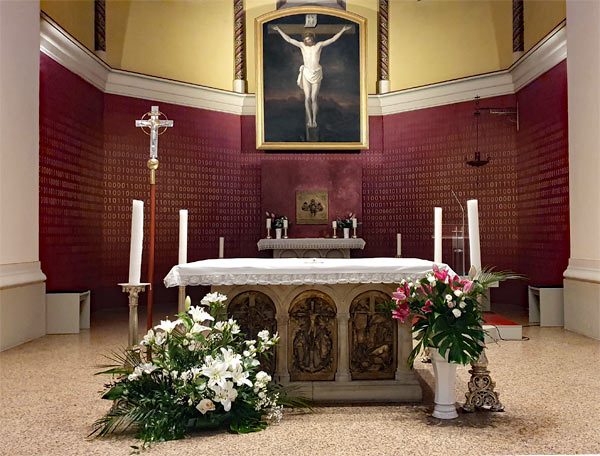Church prefers binary code in sanctuary rather than images of saints or angels
The only church in Saxony (actually in the world) with a binary code in the chancel is in Görlitz
The Church of the Holy Cross was consecrated 170 years ago in April. It was the first new Catholic church built in the city after the Reformation. Catholic Christians celebrate this Sunday.
This Sunday, the Catholic Christians in Görlitz will celebrate the consecration of the Holy Cross Church in Struvestraße 170 years ago with a German-Polish church consecration festival. The church was the first new Catholic church built in Görlitz after the Reformation.
The construction of a Catholic church in eastern Upper Lusatia, which was largely Protestant, became necessary because since 1835 there had been numerous influxes from Catholic Silesia and also from Austria, and thus a new Catholic community had emerged. Also, in the territorial reform after 1815, several royal Prussian officials of Catholic denomination were transferred to Görlitz, reported Father Carl Stiller in his records at the time.
The tapestry design in the chancel with the binary code of the numbers 1 and 0 is striking. (Cathcon: Why?????)
In 1821, there were around 200 Catholics in Görlitz, which initially led to planning permission for a chapel. Until then, Catholic pastoral care had always come from Jauernick, which was a circuitous journey for the 19th century. From 1829, a vault in a rear building on Fischmarkt/Krischelgasse served as the chapel. From 1830 onwards, Catholic masses were also held irregularly in the prison. However, although there was soon a Catholic school in Görlitz as well as permanent chaplains, a regular church was still a long time coming.
In 1844, an attempt to acquire the Annen Chapel for this purpose failed. It was not until 1845 that the building site was acquired for it from pharmacist Struve for 5,700 thalers. At that time, today's Struve Street was still called Obere Kahle. The foundation stone was laid on 27 August 1850. The ceremony was very spartan: "An act with only the singing congregation and the praying priest," reported the chronicle.
Finally, in 1853, the "Catholic Parish Church of the Holy Cross in Görlitz" was consecrated on 27 April by Auxiliary Bishop Latussek from Breslau. Here, the public was now strongly represented. In solemn procession it went from the Webertor to the new church. 34 clergymen from Silesia, Bohemia and Saxony led the procession.
Interestingly, on that very 27th April, 328 years earlier, the archpriests of Görlitz, Reichenbach/OL and Seidenberg decided to introduce the Reformation in this part of Upper Lusatia.
The building was designed by August Soller, a pupil of Schinkel. The Church was built in the round arch style of the Romanesque period. However, the sacred building has pinnacles at the corners of the roof that are untypical of the Romanesque style. The walls are made of quarry stone of Königshain granite. The interior of the church has the appearance of a hall church with consistent use of the round arch style. Silesian sandstone was used for the high altar.
In 1893, due to the large number of parishioners, a porch was added. The church is 37 metres high from the ground to the top of the steeple.
Inside, the structure with the porch is 28 metres long and 15 metres wide. A special feature of the church is that it is not ossified as usual. Thus, the steeple is in the north instead of the usual west and the choir is in the south instead of the east. To the south of the church is the parish of the Roman Catholic community of Holy Cross.
Between 1992 and 1995, as well as in 2018, the church was renovated from the ground up. In May 1995, the altar was consecrated and the church could once again be used for worship. Finally, on 3 February 2001, the consecration of the Lady Chapel took place. It is a replica of the Black Madonna of Czestochowa. This chapel was a gift from the Polish Catholics living in the Holy Cross parish area.










.jpeg)

Comments